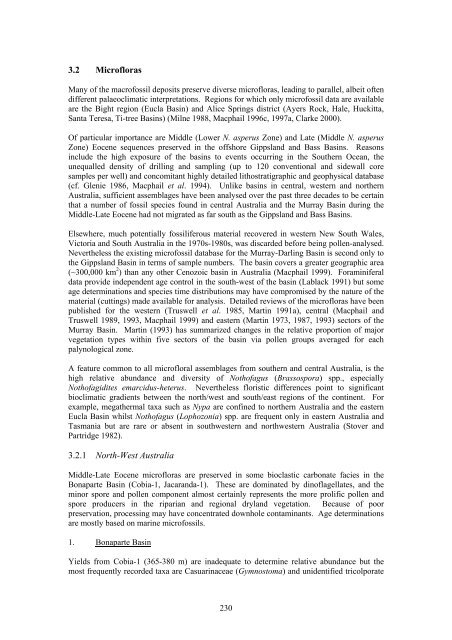OFR 151.pdf - CRC LEME
OFR 151.pdf - CRC LEME
OFR 151.pdf - CRC LEME
Create successful ePaper yourself
Turn your PDF publications into a flip-book with our unique Google optimized e-Paper software.
3.2 Microfloras<br />
Many of the macrofossil deposits preserve diverse microfloras, leading to parallel, albeit often<br />
different palaeoclimatic interpretations. Regions for which only microfossil data are available<br />
are the Bight region (Eucla Basin) and Alice Springs district (Ayers Rock, Hale, Huckitta,<br />
Santa Teresa, Ti-tree Basins) (Milne 1988, Macphail 1996c, 1997a, Clarke 2000).<br />
Of particular importance are Middle (Lower N. asperus Zone) and Late (Middle N. asperus<br />
Zone) Eocene sequences preserved in the offshore Gippsland and Bass Basins. Reasons<br />
include the high exposure of the basins to events occurring in the Southern Ocean, the<br />
unequalled density of drilling and sampling (up to 120 conventional and sidewall core<br />
samples per well) and concomitant highly detailed lithostratigraphic and geophysical database<br />
(cf. Glenie 1986, Macphail et al. 1994). Unlike basins in central, western and northern<br />
Australia, sufficient assemblages have been analysed over the past three decades to be certain<br />
that a number of fossil species found in central Australia and the Murray Basin during the<br />
Middle-Late Eocene had not migrated as far south as the Gippsland and Bass Basins.<br />
Elsewhere, much potentially fossiliferous material recovered in western New South Wales,<br />
Victoria and South Australia in the 1970s-1980s, was discarded before being pollen-analysed.<br />
Nevertheless the existing microfossil database for the Murray-Darling Basin is second only to<br />
the Gippsland Basin in terms of sample numbers. The basin covers a greater geographic area<br />
(~300,000 km 2 ) than any other Cenozoic basin in Australia (Macphail 1999). Foraminiferal<br />
data provide independent age control in the south-west of the basin (Lablack 1991) but some<br />
age determinations and species time distributions may have compromised by the nature of the<br />
material (cuttings) made available for analysis. Detailed reviews of the microfloras have been<br />
published for the western (Truswell et al. 1985, Martin 1991a), central (Macphail and<br />
Truswell 1989, 1993, Macphail 1999) and eastern (Martin 1973, 1987, 1993) sectors of the<br />
Murray Basin. Martin (1993) has summarized changes in the relative proportion of major<br />
vegetation types within five sectors of the basin via pollen groups averaged for each<br />
palynological zone.<br />
A feature common to all microfloral assemblages from southern and central Australia, is the<br />
high relative abundance and diversity of Nothofagus (Brassospora) spp., especially<br />
Nothofagidites emarcidus-heterus. Nevertheless floristic differences point to significant<br />
bioclimatic gradients between the north/west and south/east regions of the continent. For<br />
example, megathermal taxa such as Nypa are confined to northern Australia and the eastern<br />
Eucla Basin whilst Nothofagus (Lophozonia) spp. are frequent only in eastern Australia and<br />
Tasmania but are rare or absent in southwestern and northwestern Australia (Stover and<br />
Partridge 1982).<br />
3.2.1 North-West Australia<br />
Middle-Late Eocene microfloras are preserved in some bioclastic carbonate facies in the<br />
Bonaparte Basin (Cobia-1, Jacaranda-1). These are dominated by dinoflagellates, and the<br />
minor spore and pollen component almost certainly represents the more prolific pollen and<br />
spore producers in the riparian and regional dryland vegetation. Because of poor<br />
preservation, processing may have concentrated downhole contaminants. Age determinations<br />
are mostly based on marine microfossils.<br />
1. Bonaparte Basin<br />
Yields from Cobia-1 (365-380 m) are inadequate to determine relative abundance but the<br />
most frequently recorded taxa are Casuarinaceae (Gymnostoma) and unidentified tricolporate<br />
230

















